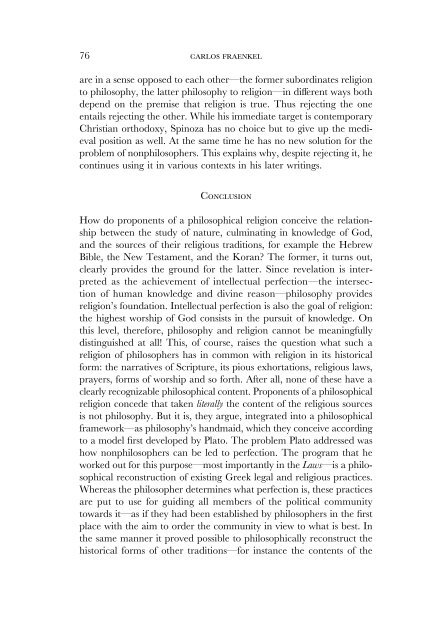Download PDF - Carlos F. Fraenkel
Download PDF - Carlos F. Fraenkel
Download PDF - Carlos F. Fraenkel
You also want an ePaper? Increase the reach of your titles
YUMPU automatically turns print PDFs into web optimized ePapers that Google loves.
76 carlos fraenkelare in a sense opposed to each other—the former subordinates religionto philosophy, the latter philosophy to religion—in different ways bothdepend on the premise that religion is true. Thus rejecting the oneentails rejecting the other. While his immediate target is contemporaryChristian orthodoxy, Spinoza has no choice but to give up the medievalposition as well. At the same time he has no new solution for theproblem of nonphilosophers. This explains why, despite rejecting it, hecontinues using it in various contexts in his later writings.ConclusionHow do proponents of a philosophical religion conceive the relationshipbetween the study of nature, culminating in knowledge of God,and the sources of their religious traditions, for example the HebrewBible, the New Testament, and the Koran? The former, it turns out,clearly provides the ground for the latter. Since revelation is interpretedas the achievement of intellectual perfection—the intersectionof human knowledge and divine reason—philosophy providesreligion’s foundation. Intellectual perfection is also the goal of religion:the highest worship of God consists in the pursuit of knowledge. Onthis level, therefore, philosophy and religion cannot be meaningfullydistinguished at all! This, of course, raises the question what such areligion of philosophers has in common with religion in its historicalform: the narratives of Scripture, its pious exhortations, religious laws,prayers, forms of worship and so forth. After all, none of these have aclearly recognizable philosophical content. Proponents of a philosophicalreligion concede that taken literally the content of the religious sourcesis not philosophy. But it is, they argue, integrated into a philosophicalframework—as philosophy’s handmaid, which they conceive accordingto a model first developed by Plato. The problem Plato addressed washow nonphilosophers can be led to perfection. The program that heworked out for this purpose—most importantly in the Laws—is a philosophicalreconstruction of existing Greek legal and religious practices.Whereas the philosopher determines what perfection is, these practicesare put to use for guiding all members of the political communitytowards it—as if they had been established by philosophers in the firstplace with the aim to order the community in view to what is best. Inthe same manner it proved possible to philosophically reconstruct thehistorical forms of other traditions—for instance the contents of the



